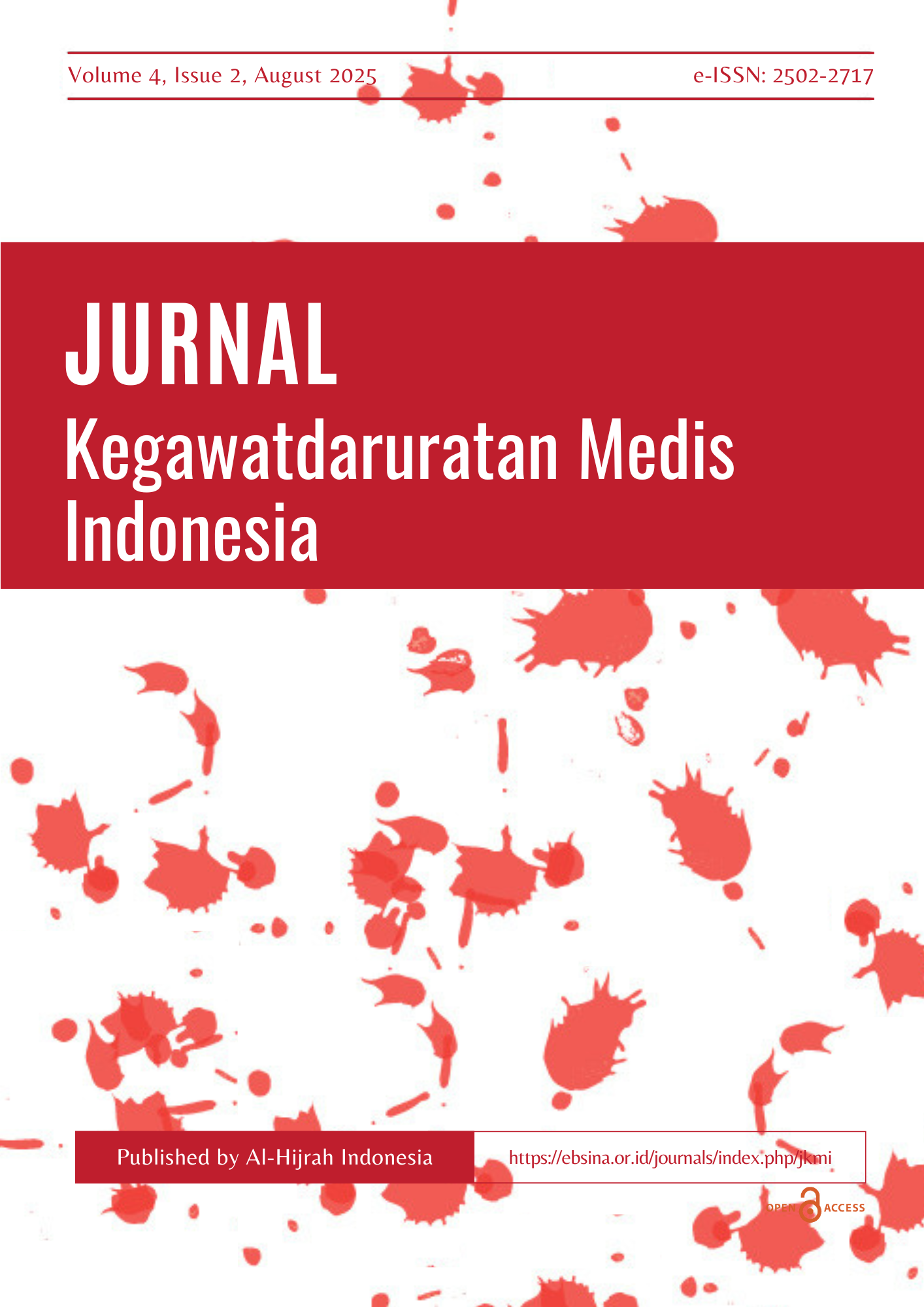
Communication, Information and Education (CIE) using Five Finger Labels to Reduce Anxiety of the Patient’s Family
DOI:
https://doi.org/10.58545/jkmi.v4i2.529Abstract
During the treatment process, anxiety could've been felt by the family that had their member treated in the hospital. This research is purposed for knowing the effect of Communication, Information, and Education (CIE) using five-finger labels on the level of anxiety of the patient's family in the emergency department. This research used quasi-experimental with pre-post test with a control group design. The sample in the research is the patient's family which is in the yellow zone of the emergency department counted 60 respondents, selected with purposive sampling. Instruments that were selected are the Anxiety questionnaire State Anxiety Inventory (S-AI) form Y. The results showed that in the experimental group, there was an increase in the number of mild anxiety levels from 53.3% to 80%, a decrease in the number of moderate anxiety levels from 43.3% to 20%, a decrease in the level of severe anxiety from 3.3% to 0%. In the control group, there was an increase in the number of mild anxiety levels from 53.3% to 60% and a decrease in moderate anxiety levels from 46.7% to 40%. The results of the Mann-Whitney statistical test obtained a significance value (p) of 0.010, which means that there was an effect of CIE using five-finger labels on the anxiety level of the patient's family in the emergency room. The results of this study are expected to be applied as an intervention in reducing the anxiety of the patient's family in the emergency room.
Keywords:
Anxiety, Emergency room, CIE, Five Finger LabelsDownloads
References
Ahmed, K. J., Pilling, J. D., Ahmed, K., & Buchan, J. (2019). Effect of a patient-information video on the preoperative anxiety levels of cataract surgery patients. Journal of cataract and refractive surgery, 45(4), 475–479. https://doi.org/10.1016/j.jcrs.2018.11.011
Amiman, S. P., Katuuk, M. and Malara, R. (2019) 'Description of the Anxiety Level of Patients in the Emergency Room', Nursing Journal, 7(2). https://10.35790/jkp.v7i2.24472.
Badra, I. W. & Susantie, N. L. G. (2018) Analysis of Factors Influencing the Anxiety Level of the Patient's Family on Nursing Services in Patients Treated in the Intensive Care Unit (ICU) of Sele Be Solu Hospital, Sorong City in 2017', Nursing Arts, 11(1), pp. 11–22. doi: 10.36741/jna.v11i1.15.
Deane, K. H. O., Jimoh, O. F., Biswas, P., O’Brien, A., Hanson, S., Abdelhamid, A. S., … Hooper, L. (2021). Omega-3 and polyunsaturated fat for prevention of depression and anxiety symptoms: systematic review and meta-analysis of randomised trials. The British Journal of Psychiatry, 218(3), 135–142. https://doi.org/10.1192/bjp.2019.234
Desridius. & Ningrum, N. P. (2018). Relationship of Therapeutic Communication to the Anxiety Level of the Patient's Family. Journal Between Nursing. 1(2), pp. 86–91. https://doi.org/10.37063/antaraperawat.v1i2.63.
Furwanti, E. (2014). Description of the Anxiety Level of Patients in the Emergency Room (IGD) Panembahan Senopati Hospital, Bantul. Yogyakarta Muhammadiyah University.
Greene, J., Cohen, D., Siskowski, C., & Toyinbo, P. (2017). The Relationship Between Family Caregiving and the Mental Health of Emerging Young Adult Caregivers. The journal of behavioral health services & research, 44(4), 551–563. https://doi.org/10.1007/s11414-016-9526-7
Hayaturrahmi, & Halimuddin. (2018). Factors Affecting the Anxiety Level of the Patient's Family in the Emergency Room. Student Scientific Journal of the Faculty of Nursing. 3(2), pp. 231–240.
Kozier, B. (2008). Fundamentals of nursing: concepts, process and practice. pearson education.
Madianingsih, A. (2017). Description of Anxiety of the Patient's Family in the Emergency Room (IGD) of RSUD Wates Kulon Progo. STIKES Achmad Yani.
McAdam, J. & Puntilo, K. (2017). Symptoms experienced by family members of patients in intensive care unit’. American Journal of critical care. 18(3), p. 200b–210.
Nugroho, F. A. (2019). The Anxiety Level of the Patient's Family in the Emergency Room (IGD) Dr. Hardjono Ponorogo. Muhammadiyah University of Ponorogo.
Nurhayati & Juniarti, A. (2020). Factors Associated with the Level of Family Anxiety in Patients in the Emergency Room. Scientific Journal of Health Multi-Science, 12(2).
Sutejo. (2017). Mental Nursing Concepts and Practices of Mental Health Nursing Care: Mental and Psychosocial Disorders. Yogyakarta: New Press Library.
Suyani, S. (2020). Hubungan Tingkat Pendidikan Dan Status Pekerjaan Dengan Kecemasan Pada Ibu Hamil Trimester III. JKM (Jurnal Kesehatan Masyarakat) Cendekia Utama, 8(1), 19-28. https://doi.org/10.31596/jkm.v8i1.563
Ugalde, A., Krishnasamy, M., & Schofield, P. (2014). The relationship between self-efficacy and anxiety and general distress in caregivers of people with advanced cancer. Journal of palliative medicine, 17(8), 939–941. https://doi.org/10.1089/jpm.2013.0338
Youssef, N. K., Mostafa, M. F., & Ibrahim, W. H. (2025). Effect of Implementing Childbirth Preparation Classes on Women's Self-efficacy and Pregnancy Outcomes. The Malaysian Journal of Nursing (MJN), 16(3), 98-108. https://doi.org/10.31674/mjn.2025.v16i03.010
Downloads
Published
How to Cite
Issue
Section
License
Copyright (c) 2025 Fitria Wahyu Ariyanti, Atikah Fatmawati, Tri Haryadi

This work is licensed under a Creative Commons Attribution-ShareAlike 4.0 International License.
Most read articles by the same author(s)
- Mujiadi, Atikah Fatmawati, The Effect of Passive Range of Motion on Recovery Time in Post-Operative Patients in the Recovery Room of Brawijaya University Hospital Malang , Jurnal Kegawatdaruratan Medis Indonesia : Vol. 2 No. 2: August 2023










